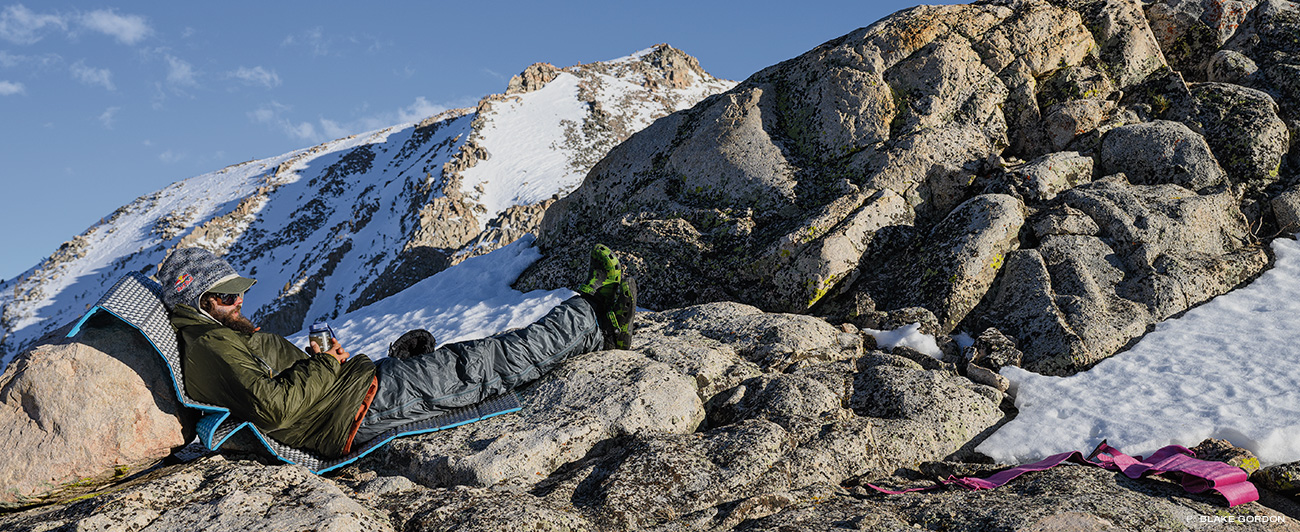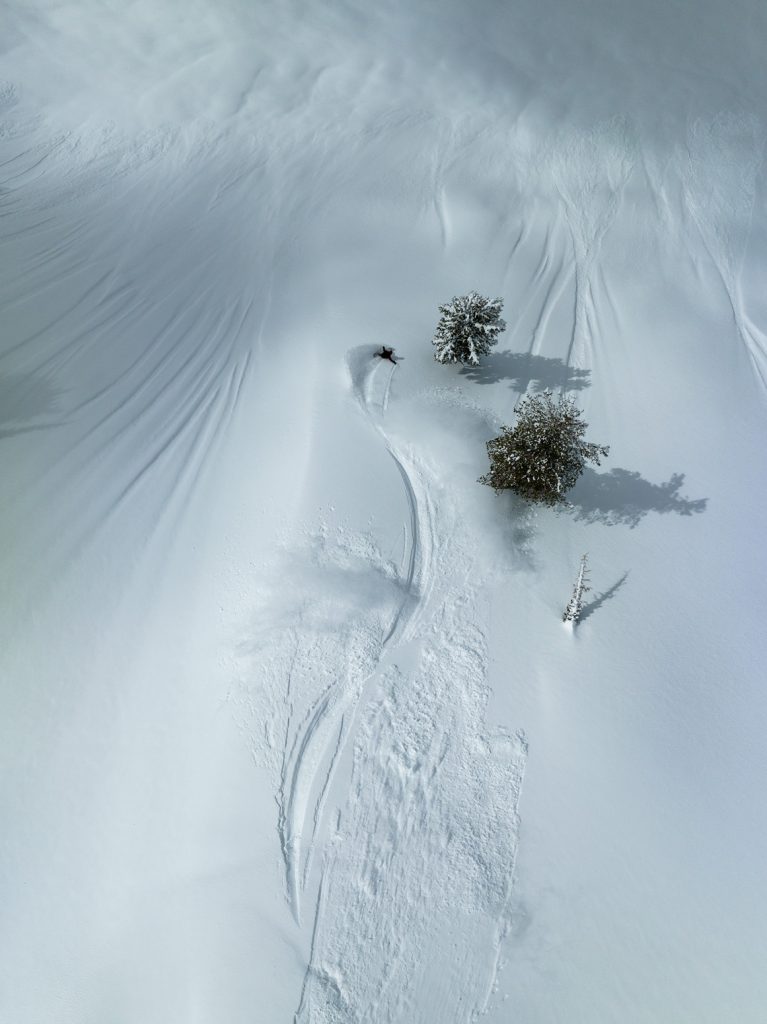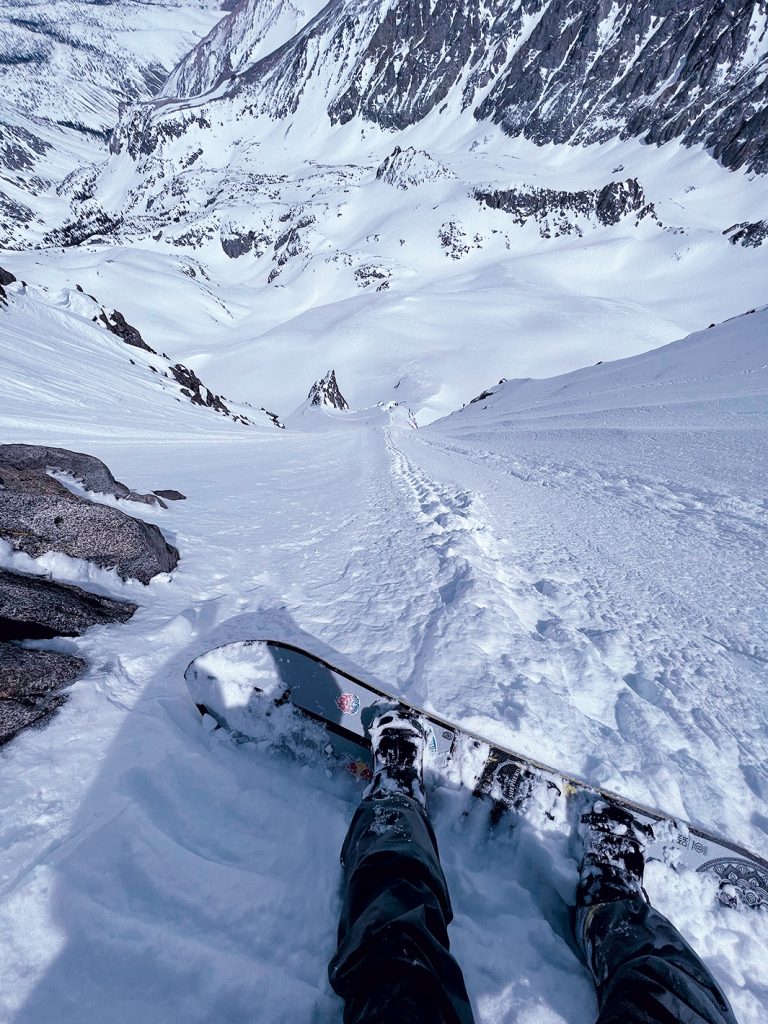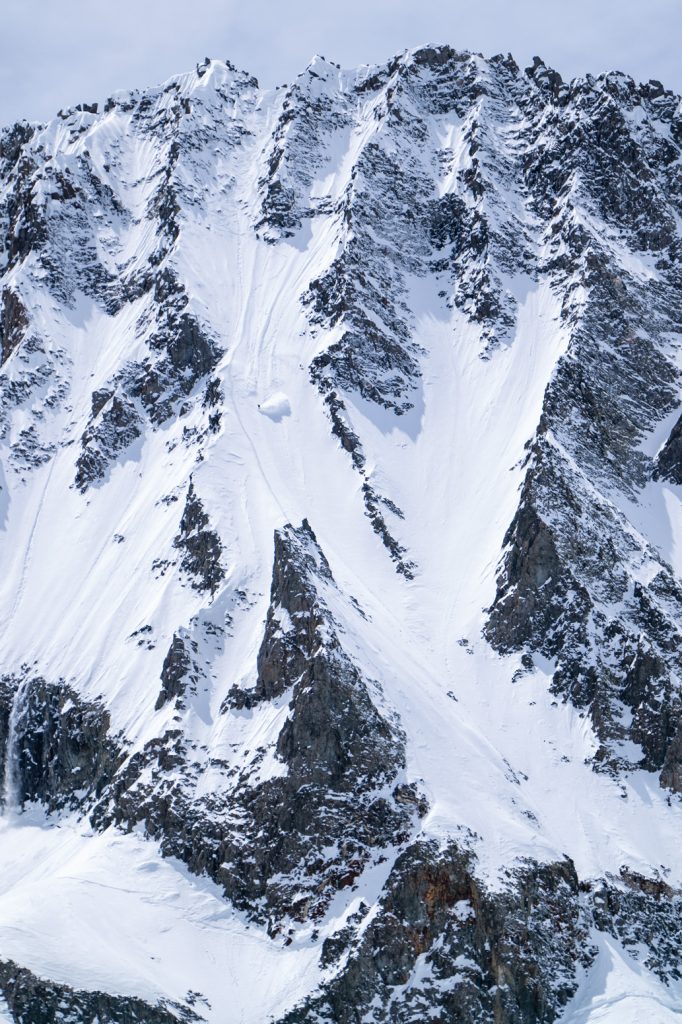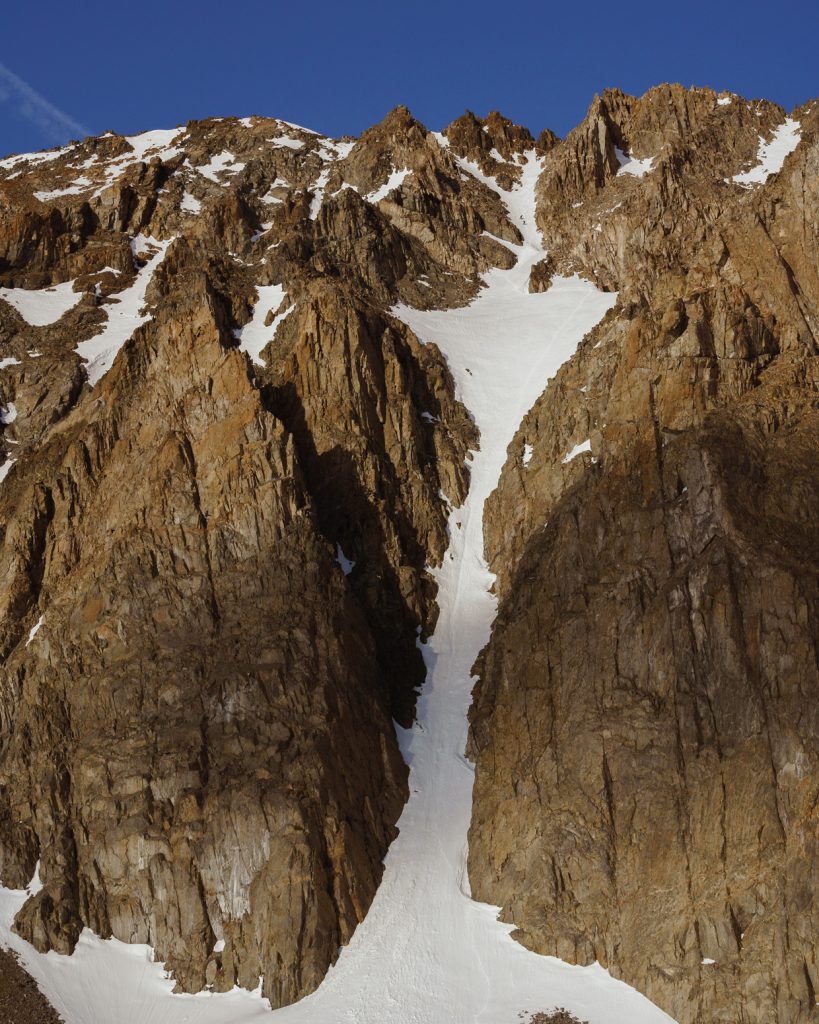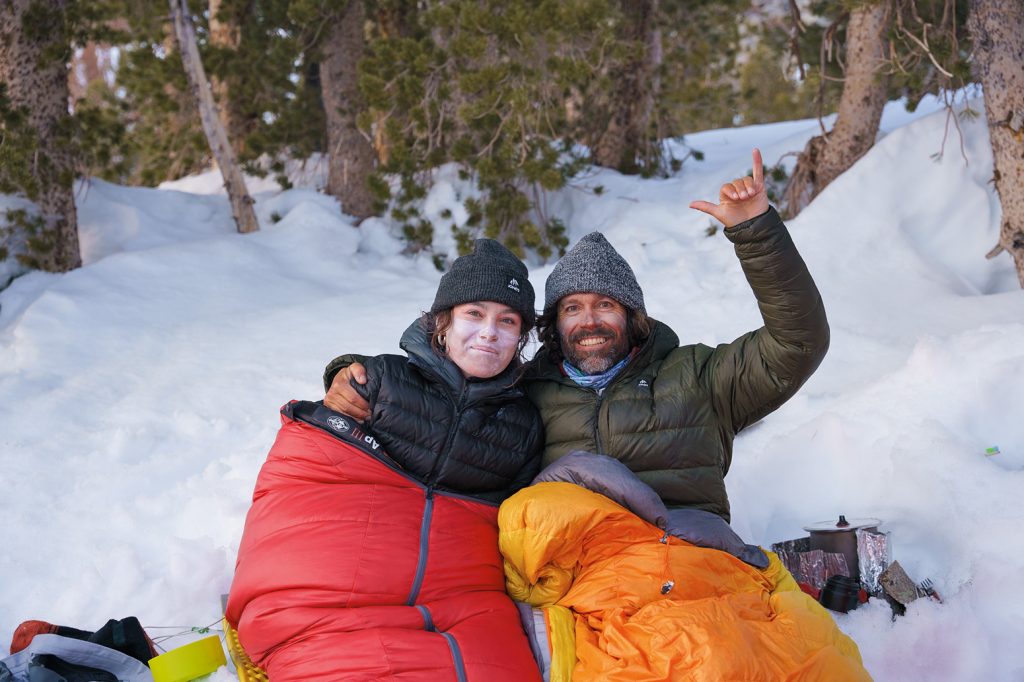Locale
Ideal Scenarios in the High Sierra
First published in Volume 21, Issue 3 of The Snowboarder’s Journal
Introduction Nick Russell
The Sierra Nevada—more specifically the High Sierra—is a gem of North American mountain ranges. In my biased opinion, this is one of the greatest places in the world for human-powered snowboarding. The high concentration of rideable terrain throughout this rugged 400-mile stretch of ridgelines topping out above 14,000 feet is a freerider’s fantasy. Combined with frequent high pressure systems allowing passage into the alpine, it’s a place of endless potential–so long as there is snow on the ground. Big snow years, particularly in the Southern Sierra, have become less and less reliable recently due to climate change. In the heart of the range, it is feast or famine. We’ve learned to be patient throughout times of hunger and even more appreciative when served a full plate.
The historic winter of ‘22/23 was favorable to much of the lower 48 and the Sierra was no exception. Monumental storm after storm blanketed the range from north to south and lines that haven’t been in for years, if ever, became fair game. It was that ideal scenario we’d all been waiting for.
Reminiscing on the past winter, a season full of memories can be broken down into a handful of standout shared experiences—a collection of literal ups and downs that vary from mundane to transformative which will forever hold a place in our hearts and minds. They range from low stress sessions to critical situations demanding absolute focus. From vision quests on a bucket list objective to sharing these wild spaces with friends and loved ones, the key element here is the landscape. But what makes this range so special is the fact that we have the privilege to recreate and immerse ourselves in such a vast land largely untouched by humans. Open to interpretation, these mountains provide us with an outlet and opportunity for varied forms of alpine wilderness experiences. The following are three moments from three perspectives from a winter where it all lined up.
“Nick Russell painting a nice track on one of the best days of the season, in the best season of our lives, in California’s Sierra Nevada.” Photo: Ming Poon
MIDDLE PALISADE
Words Nick Russell
I’ve always been drawn to lines that are accompanied by a little bit of lore–the ones that call for more effort than most and come with a low success rate. Lines where photos are sparse and firsthand accounts are even rarer. For myself, Middle Palisade is one of those mountains that I’ve long since earmarked as a true High Sierra dream line. Beyond the fact that this 14,012-foot peak holds a beautiful yet wildly exposed descent off the summit ridge, it’s how rare this intimidating line comes into form that brings much of the allure. I appreciate the process of working up to something grand and even more so if met with failure upon initial undertakings.
The first time I truly saw the face with the intention of hopefully riding it the next day was in mid-March with my good friend Nathaniel Murphy. We had climbed an opposing peak to get a view. The route essentially wraps east to north down the mountain. From the rarely snow-covered headwall off the top, one must make a critical rider’s left to avoid the 500-foot cliff below the fall line. Then, the bulk of the line opens up, until eventually leading to yet another guarded closeout where a final crucial move rider’s right must be made to reach the diagonal exit chute. In favorable conditions, she goes clean with no ropes and holds potential for good style. Looking through my monocle in the afternoon shade, even though the snow quality was a big question mark, I could tell that it was good enough to try the following day.
We set our alarms for 12 a.m. at a modest motel in Big Pine and left by 1:30 to make it to the base of Middle Palisade by sunrise. Upon first light on the skyline, those butterflies that traditionally come with a big project had multiplied. There was far more snow than either of us had anticipated, creating the kind of glorious, fluted spines normally reserved for Alaska. It looked too good. We hemmed and hawed at the base for quite some time, debating the current situation. Ultimately, the abundance of deep, unsettled snow on such a big, exposed face led to our decision to abort. Bailing isn’t always easy, but the writing was on the wall.
POV: About to drop into a dream line on Middle Palisade. Photo: Nick Russell
Several weeks later I was back home in Truckee when I received a text from friend and photographer, Ming Poon. Turns out that two mutual friends, Jeff Dostie and Jeremy Frumkin, had their own ongoing saga with Middle Palisade and were planning to give it a shot that weekend. We all crammed into the back of Dostie’s truck and made our way down Highway 395 for a late-night arrival at the trailhead and short rest. With headlamp lumens on high, we made relatively quick work of the sloggy approach–5,000 vertical feet over eight miles–to reach the base of the giant. Taking lessons from my previous attempt, we adjusted our route and came in a little higher, then traversed down to a diagonal snow pitch above the lower rocks to begin the 2,000-foot ascent.
Nothing is guaranteed in the mountains until you’re back at the bottom looking up at your tracks. That said, this was one of those days where everything felt right. I didn’t vocalize that we got this, but it’s important to acknowledge and embrace the faint voice in our minds telling us to keep going. The deck was undeniably stacked in our favor. The snowpack was healthier than it had ever been and after a winter of lines our fitness had reached a seasonal high. Ample days on the steeps by this time of year added maximum comfort to a precarious environment. Two hours spent climbing on the face translated to a symbiotic relationship with the route and current riding conditions.
It’s as good as it gets, I thought as we rhythmically worked our way up in cold, boot-top powder. Breaking trail up the belly of the beast, small spindrifts kept me honest as they occasionally started to break free from the rocks above and gain momentum down the runnels between the spines we were on. Rapid warming with unsettled snow is one of my biggest concerns, but thankfully, a thin layer of clouds kept things cool enough to maintain a reasonable level of avalanche safety. Seeing how much loose snow there was delicately hanging on the mountain, sluff was the primary hazard and staying the course on the highpoints as much as possible became the goal. Moving through the motions in that prolonged flow state is the product of time well spent.
The top-out view of a new-to-you peak is what we search for. A fresh perspective on a familiar place opens a portal to the deepest reaches of the range and sets plans for years to come. With the most serious part of the day still ahead, the reprieve from constant movement over the past eight hours was brief. Despite likely being my most consequential line of the season, I felt a peaceful calm. After navigating the crux, the possibility to freeride a big, High Sierra line was now a reality. The opportunity to open it up on a face of this size is perhaps rarer than the line itself. It’s this fleeting moment, suspended in time, that brings affirmation to this wild life we pursue.
“Nick Russell blasting turns on the steep face of Middle Palisade. This section was in perfect condition. Nick made six turns through 1,000 feet of vertical despite the ever-present exposure below. As you can see, slough was running. I was probably more puckered than him.” Photo: Ming Poon
MUST BE PRESENT TO WIN
Words Jeremy Jones
“We should do a High Sierra trip this year,” I’d muttered one too many times to my daughter, Mia. The plan and approach are the same as it has been since I went all-in on foot-powered snowboarding over 20 years ago: stuff backpacks with food, fuel and feathers and head west aiming to get a layer back into the range.
Twelve hours later, spring be damned. Wind driven snow and single digit temps in early May—where’s the beach? Is it winter’s last gasp? Temps are too cold for sun-softened snow. Will it be enough to keep us off the sun crust? Is it a futile dream? Must be present to win.
Ninety percent of the time you spend with your kids is before they are 18 years old. That thought had me cancelling trips all winter, as Mia spent her final winter at home, for now. If only I could bottle up our time together. My hope is her love of snow keeps her coming back. It was my love of those things that sent me west at 18, never to return.
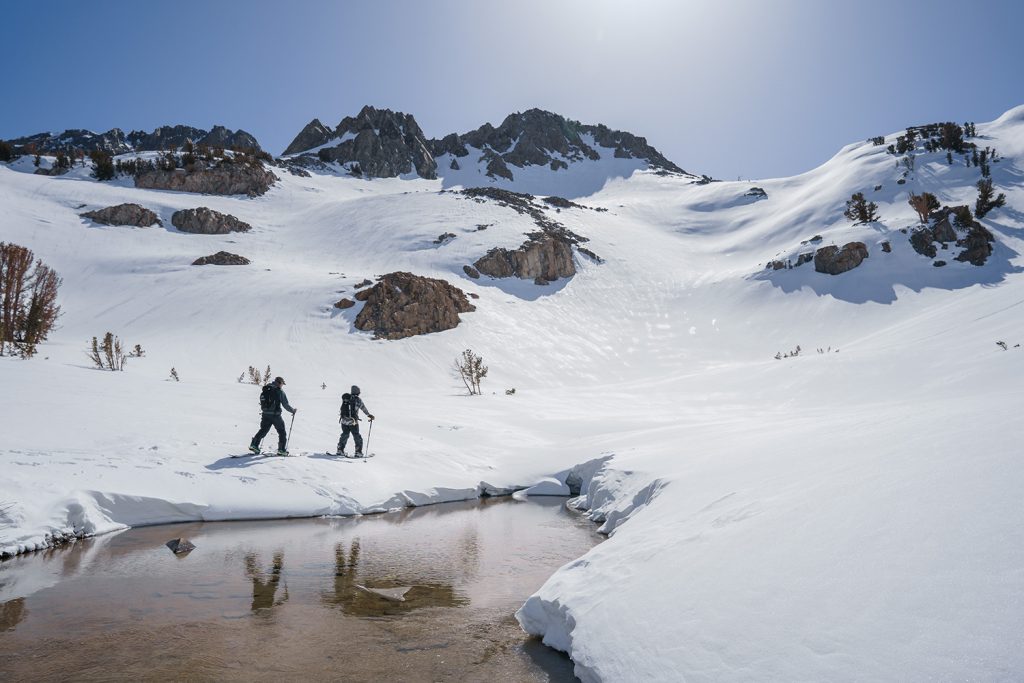
Jeremy Jones and his daughter, Mia, touring from camp to start the first day of bagging peaks and riding lines in the John Muir Wilderness, CA. Photo: Cody Mathison
Mia sleeps while I wait for the water to boil, tucked in my sleeping bag. I think back to the Deeper days in the late 2000s. Mia was an infant. That first night on a ridge with Jonaven Moore watching the sunset. He breaks the silence: “this is the coolest thing I have ever done.” We had walked through a portal away from the synthetic into the real world. The mountains saying, “Welcome, we have been waiting for you. There is a never-ending supply of mountains, and the learnings are infinite… It’s gonna be hard, but worth it.”
The High Sierra was a perfect test ground. High peaks guarded by long approaches and huge vertical relief. Dark-to-dark days left us crawling back to our car or camp completely smoked. Shooting quality footage was futile. The distances too far, the lines too big, the snow too variable, but High Sierra bred strength travelled well in other ranges.
We were all on DIY splits, carrying too much gear and not enough water. What I thought was the twilight of my career was actually the dawn. The kit has tightened up, our approach has been refined, my fitness is better, but the mountains have not gotten any smaller. Mia, however, is thriving. She got her “front pointing badge” yesterday, on bulletproof ice hidden under a few inches of powder. “If you slip you need to dive on your ice axe as fast as possible,” I warned as she got higher off the deck.
“With crampons on and ice axes in hand, Jeremy and Mia booted 1,000 vertical feet to ride this west-facing Sierra couloir. The walls glowed orange in the evening light during their descent, creating a magical shared experience.” Photo: Cody Mathison
Watch them grow and let them go. The thought wakes me from a deep sleep: “I am losing my main riding partner to college next fall.” The toughest kind of riding partner to find. The one whose stoke is not tied to conditions and who embraces less than optimal love of sport days as opportunities to progress. Yesterday we celebrated her end of adolescence with a dawn to dusk splitboard bender. It started with a high peak that appeared out of nowhere on our way to another line. The snow-covered pyramid seemed out of place in the rock laden Sierra. Halfway up, Mia took the lead over the steep convex roll to the summit. She dropped first, charging over the blind roll with speed and confidence. I took the left side of the Pyramid and mirrored her line. Two perfect tracks side by side down a fairy tale peak.
It was only a warmup for the evening encore: across the way a winding, 1,800-foot pinner couloir. We had been looking at it since the first day of our trip, wondering if it connected to the top. The morning’s vantage point confirmed it does.
Tucked behind a rock wall, our last safe spot before entering the chute, Mia and I get into full send mode. Climbing up chutes is like staring into the barrel of a shotgun for two hours—any snow or rock fall will blow you off your feet and to the bottom of the mountain. We trade leads up the couloir in a steady, continuous push. Three hours later we drop into the top part together, snaking our way through the granite hallway in golden light. The line steepens halfway down, and I take the lead to test the snow. I pull up into a small nook out of harm’s way and call over the radio: “The snow is perfect, sluff is minimal, drain it!”
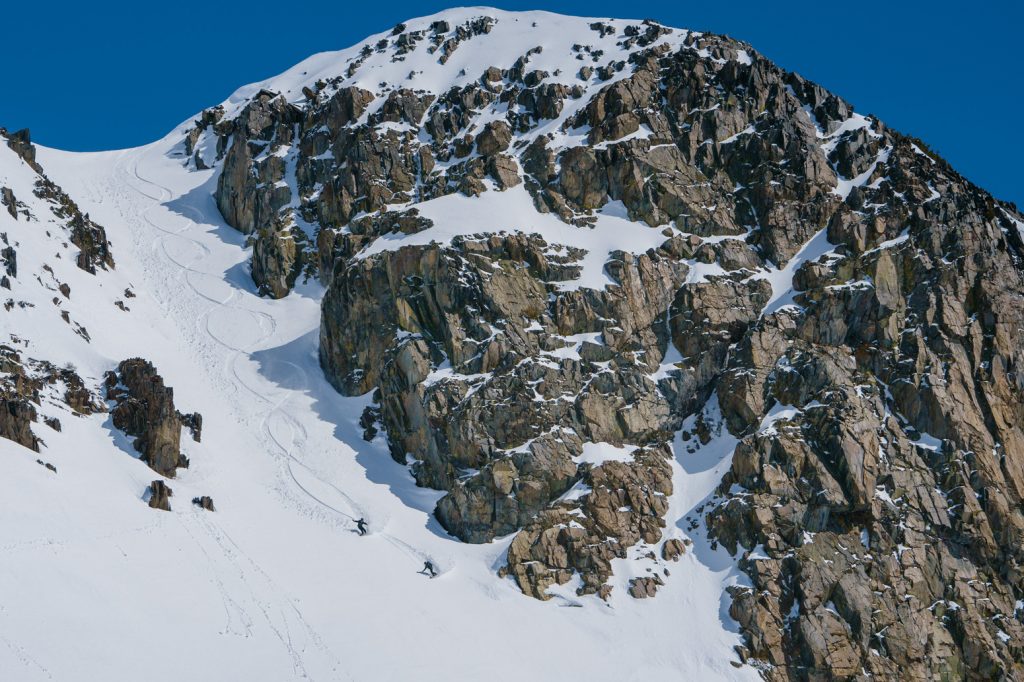
“After a small spring storm, Jeremy and Mia found five inches of fresh snow in this backcountry chute. A perfect setup for a father-daughter doubles run.” Photo: Cody Mathison
With a setting sun, she comes into view railing turns past me and out of view. Few people I know could charge a line in snow like this with as much power and grace—a testament to all those less than optimal resort days.
We embrace at the bottom. The sky is glowing and so are we. Together we wind through banks, waves, and rolls back to camp in the twilight of the day, and the twilight of her childhood. She has earned her Shralpinist badge. It is now her time to break trail and lead.
“Jeremy and Mia bundle up in their sleeping bags while preparing their favorite ramen recipe on the last night of the trip.” Photo: Cody Mathison
THE LESS OBVIOUS
Words Elena Hight
It was late into May, bordering on June, which after a long winter can feel too late to still be amping to shred. However, with so much snow lingering and a forecast for great weather, photographer Ming Poon and I decided to strike mission to the east side of the Sierra for a few days of spring corn harvesting. En route, we met up with local east side crusher Zak Mills and car camped on a lonely dirt road at about 5,500 feet of elevation. We spent the evening staring into the range, scheming about timing, approach options, and all the potential the range had to offer after a record-breaking winter. We landed on an objective for the following day: a front range peak that we could see from camp—not the tallest mountain around, but one that had a perfect couloir on it just asking to be ridden in boot-deep signature Sierra corn.
We rolled out of our camp at dawn. Sunrise over the Great Basin Desert is always beautiful, but watching the colors come to life while casually e-biking towards snow-covered mountains really upped the ante. This year, because of the massive amounts of water, the desert was completely green and blooming with wildflowers. A sea of bright purple lupines, pops of pink desert peach, yellow brittlebush, and bright red Indian paintbrush covered the hills.
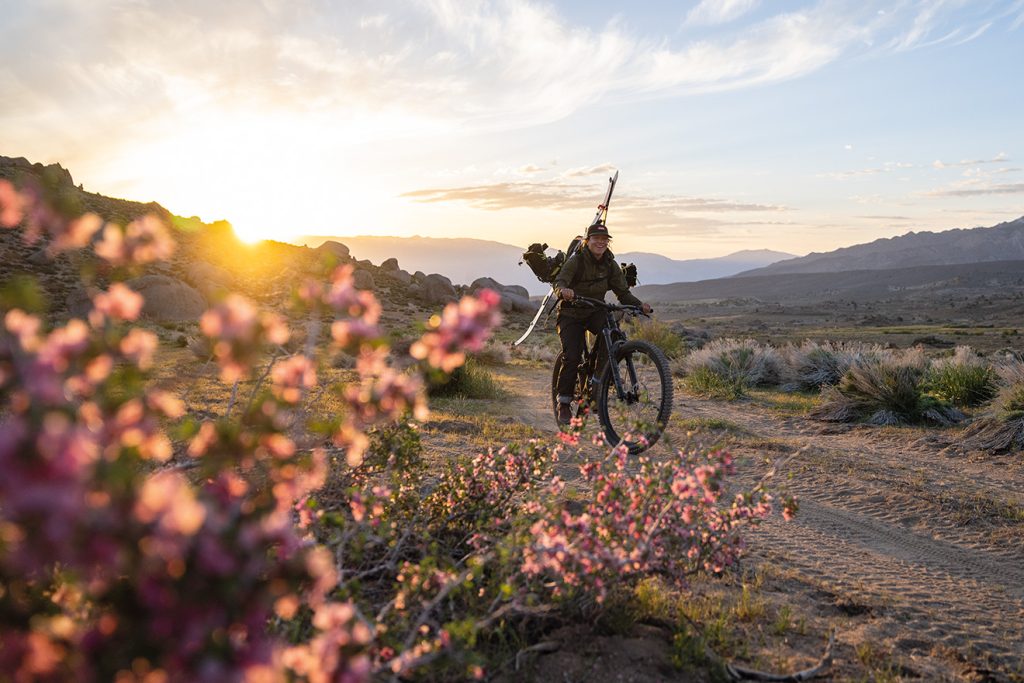
“Elena Hight riding through the desert at sunrise, approaching an eastern Sierra peak outside Bishop, CA. E-bikes, particularly full-suspension bikes, have become an integral part of our kits. They allow us to approach objectives more efficiently via old mining roads and trails. This day we biked over four miles and 2,000 vertical feet to snowline. It’s faster than a car on road sections, especially on the down, and allows us to ride cross country and single track where cars can’t go. Plus, it’s just more fun. Photo: Ming Poon
Cruising up dirt roads for around six miles and 2,000 vertical feet, it took us about two hours to get to our start zone. We never would have made it to our objective without super capable e-bikes, which have become a total game-changer for spring approaches when the roads are closed and the snowline is high. With an historical melt-off underway, we rallied through what felt like full blown rivers running down the road. Mostly unscathed (despite a few hard bails off the bikes with splitboards on our backs) we arrived at snowline. Shoes off, boots and skins on. The switch of approach mode is always kind of nice: new muscles, new blisters, new outfits.
Now at about 7,500 feet, we aimed to gain another 4,500 or so to the top. The objective was just behind the ridgeline in front of us. It held a pretty consistent 40–45-degree incline, starting with a few open panels leading into a wide, bending couloir flowing into various drainages back down to the desert.
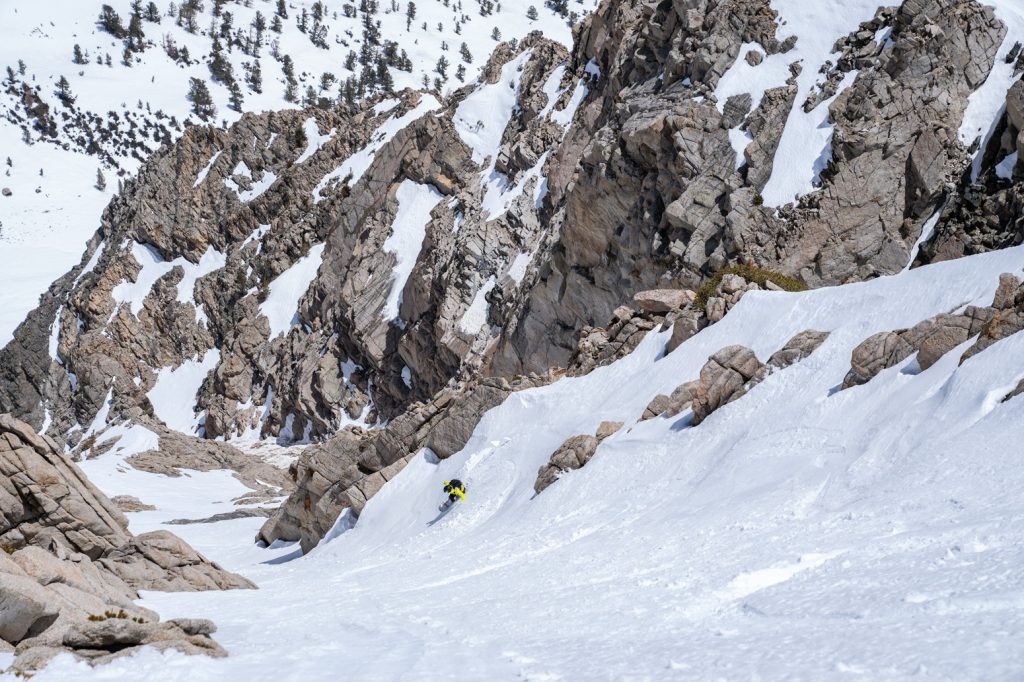
“Elena Hight with her signature style on an obscure peak and line outside Bishop, CA.” Photo: Ming Poon
When choosing objectives or lines, it is easy to get pulled to the biggest, steepest, most impressive mountain one can see. However, being open to the less obvious, the hidden lines, or less proud mountains can lead to the true hidden gems of the range. Sure, standing on the highest peak around is fun and satisfying, but oftentimes the highest quality turns are found around the corner and just out of sight. While this objective wasn’t the proudest peak on the horizon, it was an obvious couloir surrounded by large granite walls tucked away beneath its towering neighbors—something special you could easily overlook if you solely scanned the skyline.
Our approach was straight forward and began in large sun cups. A heat wave had arrived a few days prior and really took its toll on lower elevations, but cool early morning temps allowed us to glide over the divots towards better snow up high. One section of bushwhacking to get over the first ridge then straight on till morning—or more precisely, straight on to the couloir. The exciting morning e-bike ride started to fade the same way sunrises tend to do as the day presses on.
At the base of the couloir, we were met with perfect boot-packing conditions; snow that is still mostly frozen from the previous night yet soft enough to get your toes into the top layer and feel secure with each step, without sinking in. The type of snow that’s about as close as you can get to an automatic stair stepper at the gym. Reliable, consistent, and allowing a fast, rhythmic pace. Zak took the lead and we continued on. Zak is a staple in the Eastern Sierra shredding scene, having ridden most of the mountains we could see over the previous few months. Nevertheless, he hadn’t touched this one.
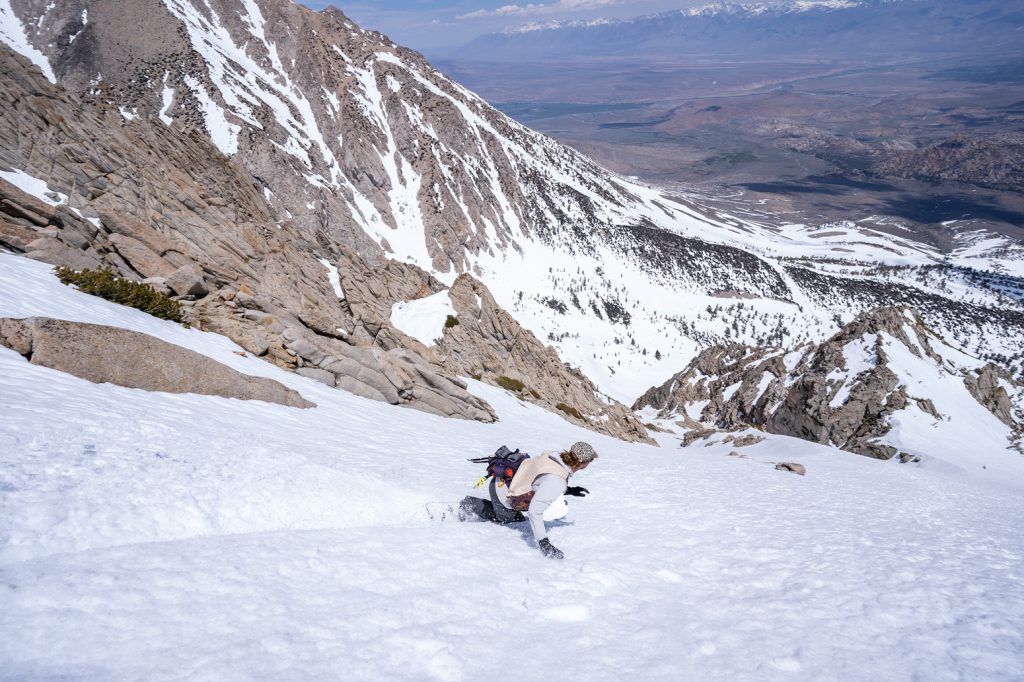
“On this day, Zak Mills brought a fanny pack which he has figured out how to use to carry his board going up and hold his poles for the way down. It looked so light and free, something I’ve never seen or experienced. As usual, he appeared to be having the most fun.” Photo: Ming Poon
About six hours into the day, the heat set in as we neared the top of our line. Hiking through knee-deep corn and sugar snow, I followed Zak to the shoulder of the bending couloir. The soft corn was just asking to be slashed and the granite walls provided natural curves to follow.
After earning your turns the downhill rarely seems to last long enough, but this line felt longer than expected. Dipping around rock features, bending in and out of the sun and shadow line, we were able to milk every last drop of it. We rode leapfrogging two-thirds of the way down. Ming would post up somewhere with a photo in mind, I would take the lead drawing lines aiming at waves to slash and rocks to ollie, then Zak would hop ahead for the next pitch, doing the same. On the bottom portion of the line, we got into group party shred mode, drawing figure eights in the snow, hooting and hollering all the way to a stop on the bench.
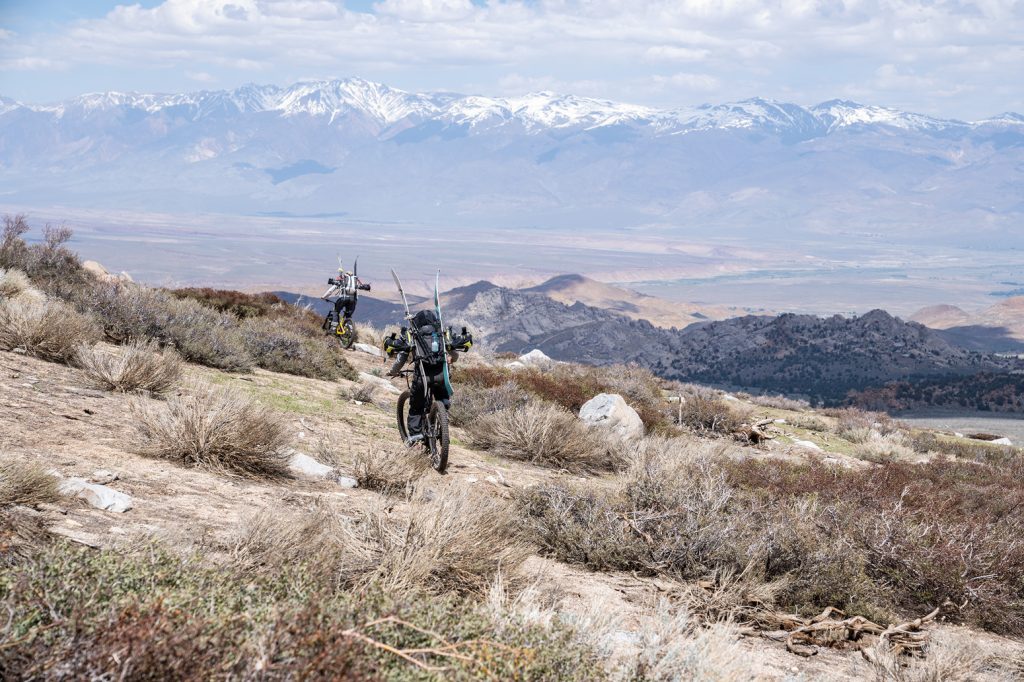
Zak Mills and Elena Hight enjoying the descent in full, even after the snow runs out. Photo: Ming Poon
With a quick walk to gain a lower ridgeline, we were soon back on our boards with tiny e-bikes in view towards the valley floor. These lower elevations where we had crossed the frozen sun cups earlier in the day were now full of deep slush cups. Hopping and bouncing through them felt like a reverse mogul run in all the best ways. There was no proper way to ride, just freedom to bounce and laugh and slash. Soon thereafter, we dipped and turned and rallied down the dirt road on our bikes. It felt similar to the couloir, the simple joy of the downhill pursuit.
This late in the season, the full experience of the day creates the high value. It might not be the best snow you have ridden all year, or the most radical line, but the long, full day leaves you with a feeling unique unto itself. After a long winter spent in cold mountain environments, it can be enticing to just bail on spring riding and decompress. However, I find spending these days in the High Sierra tapping into the mountain energy and feeding that stoke of shredding is the best decompression there is. We still have vivid memories of winter and cold smoke turns yet feel the warm sun beating down. We get to take our boots off and step into flip flops and relish the longer days, the blooming flowers and promise of summer around the corner, with winter still somehow holding on.
